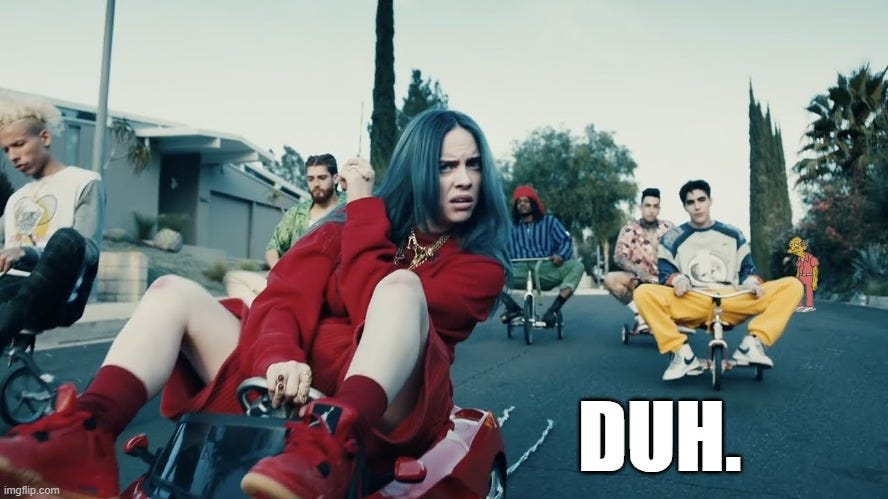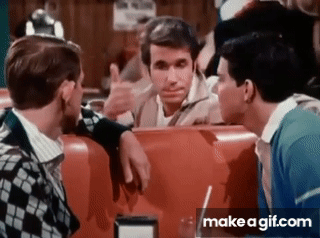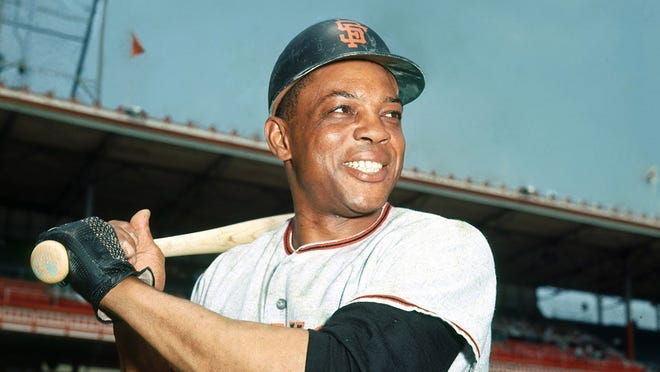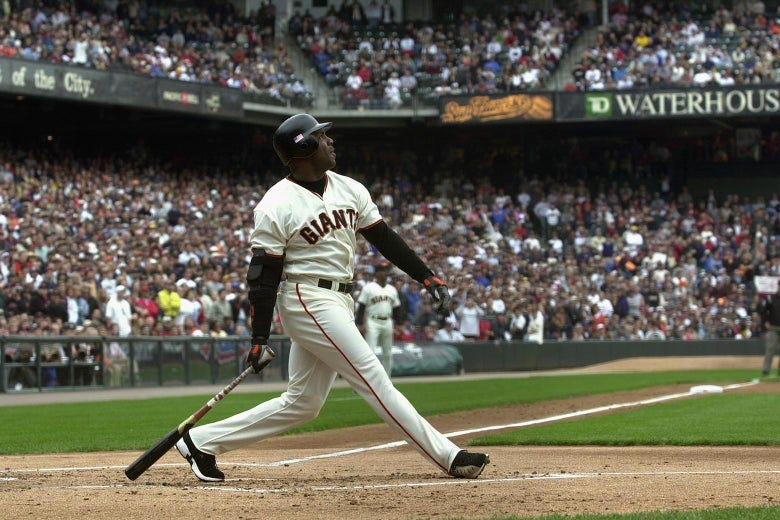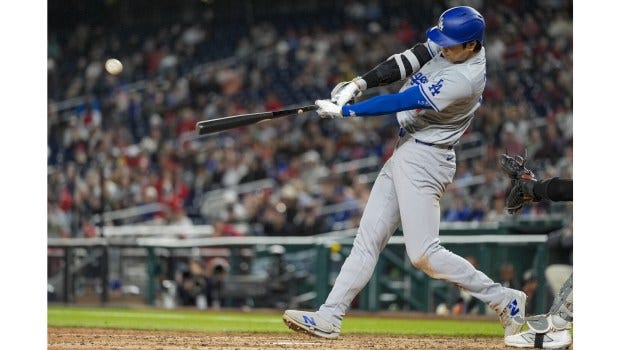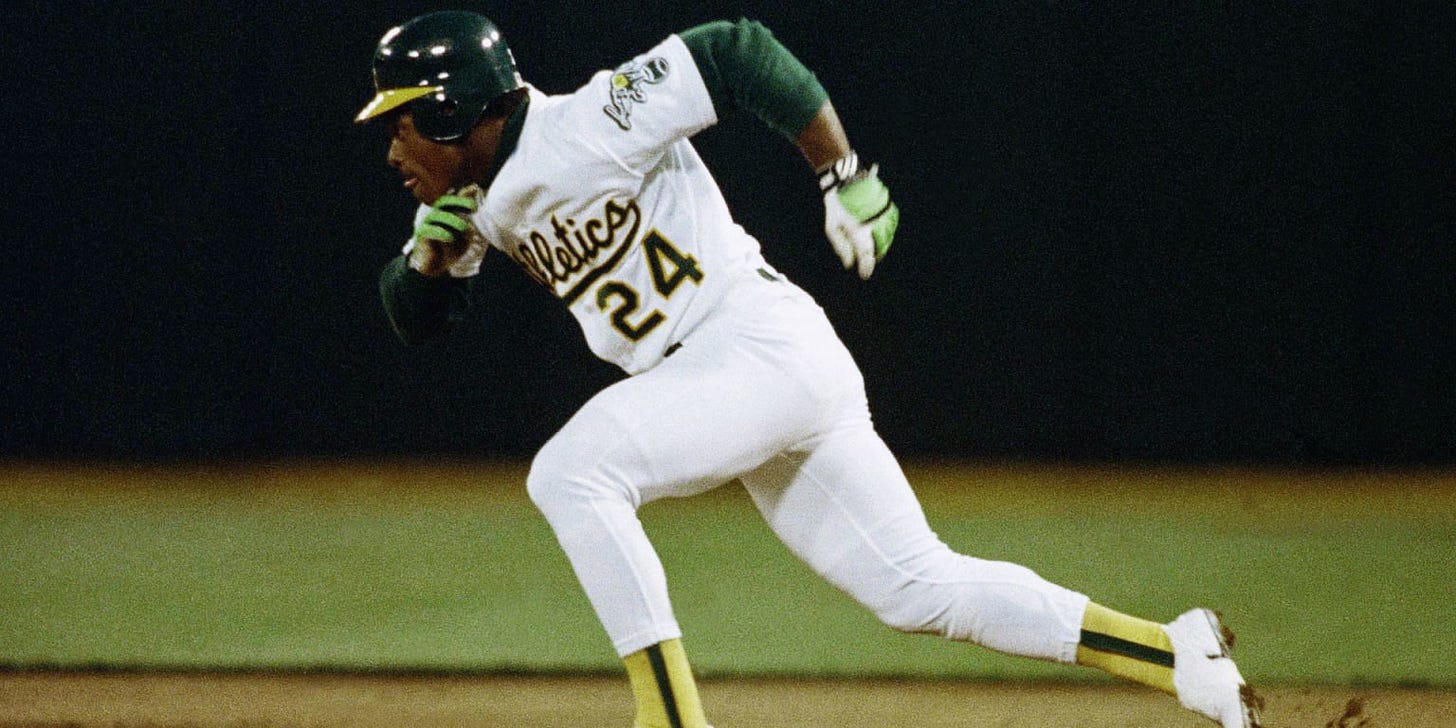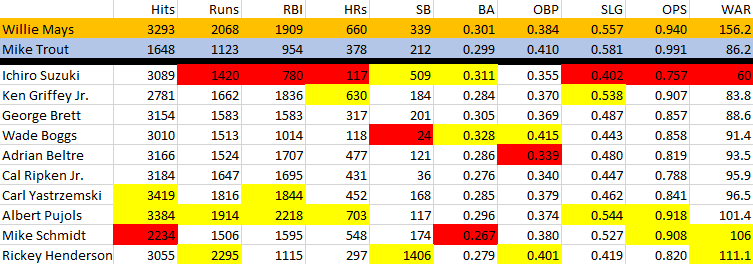Democrats Can Win This Election. It's Time They Quit Panicking and Just Get in the Ring and Fight.
PLUS: Willie Mays was the greatest living baseball player. Who holds that honor now?

So there’s going to be a presidential debate this Thursday. This is the earliest such a debate has ever occurred during an election cycle. Joe Biden and Donald Trump aren’t even officially their parties’ nominees yet. Maybe that means if one of them bombs, their party still has time to replace them with a different candidate.
It seems a lot of Americans would respond positively to such a development. Americans are rather unenthusiastic about their choices for president this fall. It kind of makes me wonder if many people beyond your run-of-the-mill political junkies will even tune into the debate this week. Biden and Trump are two well-known and disliked political figures who already did this four years ago, so your average American knows what to expect. I think there’s an Indiana Fever game on that night, so I might watch Caitlin Clark instead.
I’m probably like many Democrats in that regard. There is simply no buzz in the party around Biden’s candidacy, no sense that party members ought to step up and rally around their nominee by, say, boosting him on social media or tuning into the debate. There is plenty of buzz around Trump’s campaign, of course, although it’s the kind of buzz typically associated with a swarm of killer bees descending upon someone who has wandered too close to their hive. Biden doesn’t inspire anything close to that level of enthusiasm within his party or among those inclined to support the Democrats.
Chalk it up to Biden’s age or his skill as a communicator. There are also plenty of Democrats and Democratic leaners who have been underwhelmed by his presidency despite an impressive list of legislative accomplishments achieved with razor-thin margins in Congress. But Biden is even struggling to rouse the party faithful from their listlessness this election season.
There are five reasons for that. The first is fatigue. It’s been nine years since Trump descended that escalator. After all that time, it’s become hard to muster on a daily basis the energy needed to deal with the sludge-spewing firehose that is Trump and the MAGAverse. The second is politesse. People generally avoid discussing politics in polite company with friends and strangers alike, as passions can turn hot fairly quickly, but it’s also not impossible to have a respectful, lowkey conversation about politics with someone. Trump, however, has made politics so toxic and high-stakes that well-meaning people prefer to avoid the topic all together than potentially allow it to ruin a relationship or social occasion.
A sense of inefficacy is also a factor. A lot of Democrats don’t know what more they can do to turn the tide against Trump. They’ve appealed to the facts, to morals, to emotions; they’ve hammered home the obvious and let the obvious speak for itself; they’ve expressed outrage, prodded people with questions, engaged in fair-minded debate, and turned to mockery; they’ve sympathized and conceded points and objected strenuously; they’ve cited God and country and the public good and naked self-interest; they’ve called out the big stuff and the little stuff, the serious stuff and the absurd; they’ve focused on single issues and rattled through lists of offenses; they’ve called out hypocrisy and falsehoods and let them both slide. None of it seems to move the needle anymore. And that’s led to a feeling of resignation, the sense that the die has already been cast, that people’s minds are already made up, and that it’s just a matter of waiting until November for the election results to come in. Finally, many Democrats are experiencing dread: Not only do they feel the election has already been decided, but they fear Trump already has it wrapped up.
I’m not immune to feeling that way either. As a political scientist, I’m aware of the limits to the power of political persuasion. Most people probably do have their minds made up by now, and if not, are probably leaning pretty strongly in one direction or the other. And as the writer of this newsletter, which is “mostly about politics, focusing on hope and/or doom,” I do feel like I dwell more on doom than hope.
But Democrats need to snap out of their funk. It’s not only that their pessimism runs the risk of becoming a self-fulfilling prophecy by disillusioning those who are interested in voting for Biden while sapping the campaign of the energy needed to mount a successful run for the White House. It’s that despite the conventional wisdom, the political “vibes” (whatever that means), and what the polls may be telling us, this remains a very winnable election for Joe Biden. Consider:
Biden and Trump have run against each before, and Biden won. That doesn’t mean Biden is destined to win again, but it does mean the American people have expressed a preference for Biden over Trump in the recent past. Many of the reasons for voting for Biden over Trump in 2020 still apply today.
The race is close. Biden has dreadful approval ratings, but that doesn’t mean Trump is crushing Biden in the polls. In head-to-head match-ups with Trump, Biden is actually holding his own. In fact, just this past week, Biden inched ahead of Trump for the first time in 538’s presidential tracking poll of polls.
In 538’s simulations, Biden wins the election 50% of the time. Democrats are probably frustrated because they believe Biden should be blowing Trump out by now. Democrats should instead accept this race was always going to be close and act accordingly. If they do, they could potentially recreate Biden’s 2020 margins.
Biden is holding his own in the key battleground states. Biden does not need to recreate his electoral map from 2020 to win re-election. He just needs to get to 270 electoral votes. He can do that even if Trump pries away Arizona, Georgia, and Nevada so long as Biden hangs on to the “Blue Wall” states of Wisconsin, Michigan, and Pennsylvania along with the stray electoral vote from Nebraska’s 2nd congressional district:
Polling suggests Biden is doing better in that last group of states than in the first group. It’s still a dogfight, but despite his low national numbers, those are very winnable contests and the Biden campaign is laser-focused on them. Don’t get hung-up on reports that states like Minnesota and Virginia are beginning to tilt toward Trump. That may be the case, but if Biden loses those states, the Blue Wall will almost certainly fall as well. If Biden tends to the Blue Wall, e should be fine in the other states he would need to win to get to 270.
Democratic congressional candidates are not getting dragged down by Biden. It’s not surprising to see incumbent Democratic legislators in battleground states running ahead of the president in polling, since state and local politicians can usually tailor their appeal to a narrower constituency than the president. But I would expect voters intent on throwing the president out of office to also sour on candidates affiliated with the president’s party, especially in our time of political polarization when fewer voters are inclined to split their tickets. Polls do not suggest that is happening. For instance, Democratic incumbents running for Senate in Wisconsin, Pennsylvania, Nevada, and even Ohio are leading their races and holding up quite well. That’s led many to conclude the problem with Biden’s campaign isn’t ideological but centered on the person of Joe Biden himself. If Biden can convince people to focus more on his message than on the messenger, his numbers should start to tick up.
Biden’s opponent is Donald Trump.
I know, but Donald Trump is not a well-liked politician. I know there’s some nostalgia for his presidency, and countless articles have been written about the nation’s “collective amnesia” when it comes to what happened during his time in office, but there are plenty of people who aren’t registered Democrats who definitely haven’t forgotten. Since the last election, Trump has done little to rehabilitate his image; instead, he’s fomented an insurrection, stole a bunch of classified documents, hung-out with neo-Nazis, been found liable for sexual assault, and become a felon. People may not like voting for Joe Biden, but voting for Biden doesn’t make voters feel dirty.
MAGA is unpopular. Only about 25% of Americans have a favorable view of the MAGA movement. That’s the movement the Republican nominee for president leads. A big part of Trump’s appeal is that he is not a “mainstream” candidate, but voters don’t much care for the stream he comes from.
The Republican Party is a mess. This hasn’t really come into play yet, but it could. The Democratic Party is pretty unified right now. The GOP is not despite putting on a unified face. Trump can’t count on the votes of conservative Never-Trumpers. Right-wingers in Congress keep pulling the party to the radical right and periodically plunge the House into chaos. Republicans keep sending mixed messages to Americans about where they stand on abortion. The RNC is basically an arm of the Trump family business. With so many sketchy MAGA candidates running for office this year (see Mark Robinson) the party is due for another high profile election year meltdown.
Democrats have run well in congressional, statewide, and special elections since 2022. The parties of sitting presidents typically struggle at the ballot box during midterm and special elections. Democrats, however, have fared surprisingly well while Biden has been in office. They did not suffer the crushing losses many expected to occur during the 2022 midterms, and in regular and special elections since then, Democrats have overperformed. Even when they lose, they often lose by smaller than expected margins. Those elections aren’t necessarily predictive of what will happen in 2024, and Trump has an uncanny ability to overperform expectations when he’s on the ballot, but these results suggest the Democratic brand is strong, while the Republican Party’s affiliation with the MAGA and anti-abortion movements is a liability.
Biden is doing surprisingly well with older voters. It’s generally assumed older voters (those over the age of 65) vote Republican. Bill Clinton and Al Gore peeled them away in the 1990s, but seniors have been reliably Republican since the 1970s. Yet Biden has a slight lead in that demographic this year. Why is that? I suspect it’s because they’re higher information voters who receive their political news from more traditional news sources and therefore have a more complete picture of the candidates’ records. They’re probably more aware of Biden’s legislative successes (including his prescription drug plan), the GOP’s disarray, and Trump’s legal troubles. Retirees may also be more protective of American institutions and see Trump as a threat to the nation’s stability. It may even be that criticism of Biden’s age don’t rest well with older voters. Whatever the reason, this is a pleasant development, as older voters are more reliable voters (and maybe less likely to change their minds between now and Election Day) and disproportionately located in the northeastern and midwestern states Biden needs to win. Hopefully these voters don’t revert to their type come November.
The economy is strong. No, really, the economy is strong. Job growth is steady, unemployment is low, wages are rising, the stock market keeps climbing, GDP continues to rise, and inflation has cooled. People are still sore about prices being higher than they were four years ago, and I suspect the rising cost of housing is a concern. Still, there are a lot of positives Democrats can point to in order to emphasize the county is on a solid economic footing and headed in the right direction.
Crime is down. No, really, crime is down. Way down. The violent crime rate is not only way lower than its 1990s peak, but it is lower than it was during the pandemic and near a fifty-year low. Trump’s claim that crime is out of control is simply not true.
Many of the issues voters are mad at Biden about would be made worse under Trump. Biden doesn’t have to play defense on a lot of these issues. If voters are mad he hasn’t done enough about climate change, he can point to the climate change provisions in the Inflation Reduction Act and then pivot to how Trump’s policies would make climate change worse. If voters are mad at Biden about Israel, Biden should point out he’s endorsed a cease fire plan while Trump wouldn’t push back against Netanyahu at all. If voters are mad at Biden about immigration, he can point out he endorsed a bipartisan bill to secure the border that Trump ordered his congressional Republican cronies to kill. If voters are mad at Biden about inflation, he can point out he got inflation under control while Trump’s economic policies—which include placing commerce-killing tariffs on imports, cutting taxes for millionaires and corporations, and increasing the nation’s dependence on fossil fuels—would supercharge inflation and likely lead to stagflation. Democrats have a good case to make on all these issues.
So things aren’t as bad for Joe Biden and the Democrats as all the doomsayers would have us believe. Democrats have to accept they’re facing some strong headwinds and admit this was always going to be a close election. But they also need to recognize their electoral strengths and push their case hard with the American people. This is a very winnable election.
Young voters—particularly young, male minority voters—pose perhaps the most vexing challenge to Democrats. Many have grown disillusioned with Biden. Others are low information voters who do not consume traditional news media and are thus difficult to reach. There are signs young voters may be trending more conservative as well. But Democrats have had success connecting with this demographic in the recent past and could do so again if they put in the effort.
It’s hard to know how many persuadable voters there are out there. Some polls indicate a lot of voters may still change their minds. Trump is the sort of candidate who could easily sabotage his own campaign. Given how well-known both candidates are, however, it’s also reasonable to assume most people have already made up their minds. But given how disliked both candidates are, many people may have not yet decided if they will vote. If that’s the case, this race will come down to turnout, which is all the more reason for Democrats to go on the offensive.
Voters can smell weakness. When they hear candidates ducking the issues, conceding arguments, or avoiding debates all together, they sense those candidates don’t have a strong case to make for themselves. That’s what too many Democrats seem to be doing right now. But Democrats have a lot going for them in this election, and they’re well positioned to win it. They won’t unless they get in the ring and fight.
Signals and Noise
Democracy Watch
Erin Mansfield of USA Today counts 334 state elections officials in swing states who have undermined or cast doubt on the validity of elections.
Trump dirty trickster Roger Stone was caught on tape discussing the Trump campaign’s plan to challenge the results of the 2024 election.
Luke Broadwater of the New York Times looks at a rule Republicans have put in place in the House of Representatives that prohibits members from mentioning that Don Trump is a felon even though that has been established as a fact. Republicans claim the rule is in place to keep members from disparaging a president, yet Republicans often refer to President Biden as a criminal even though their own investigations have proven otherwise.
By Peter Wehner of The Atlantic: “The Motivated Ignorance of Trump Supporters” (“Throughout my career I’ve tried to resist the temptation to make unwarranted judgments about the character of people based on their political views….But something has changed for me in the Trump era. I struggle more than I once did to wall off a person’s character from their politics when their politics is binding them to an unusually—and I would say undeniably—destructive person. The lies that MAGA world parrots are so manifestly untrue, and the Trump ethic is so manifestly cruel, that they are difficult to set aside. If a person insists, despite the overwhelming evidence, that Trump was the target of an assassination plot hatched by Biden and carried out by the FBI, this is more than an intellectual failure; it is a moral failure, and a serious one at that. It’s only reasonable to conclude that such Trump supporters have not made a good-faith effort to understand what is really and truly happening.”)
The 2024 Election
By Matthew Yglesias of Slow Boring: “Trump’s Presidency was a Huge Mess”
Don Trump held campaign events last Saturday in Detroit at both a Black church (where he drew a small, mostly white crowd) and in front of a group that has courted white supremacists.
Not only did Trump spend the week praising Milwaukee, the site of the 2024 Republican National Convention, after calling it a “horrible” city a few weeks ago, but he also announced he planned on staying in the city during the convention after a report leaked he was going to commute to Milwaukee from Chicago (where he owns a hotel) every day of the convention. Local Milwaukee residents weren’t impressed:
By Jonathan Chait of New York: “Trump’s Tariff Is a Scheme to Shift the Tax Burden to the Non-Rich” (“The protectionist aspect of Trump’s economic agenda does indeed represent a genuine break from party orthodoxy. But Trump has managed to integrate it into the Republican program by turning it into a vehicle for regressive tax cuts. In recent weeks, he has built momentum among Republican billionaires who responded queasily to January 6, even as he has pushed his tariff proposals in more radical directions. That is not a contradiction but a natural synthesis of Trump’s protectionist impulse and the party’s general mania for relieving the wealthy of their obligations to fund the government.”)
Richard Rubin of the Wall Street Journal reports on a major issue at stake in the 2024 election: The corporate tax rate. Biden supports raising it from 21% to 28%, while Trump favors lowering it to 15%.
Trump attacked Biden’s moves to forgive billions of dollars in student debt.
In campaign finance news, Michael Bloomberg donated over $19 million to a Biden-affiliated super PAC while Timothy Mellon donated $50 million to a Trump-affiliated super PAC.
Conservative media outlets are posting misleading stories about Biden’s fitness for public office that include deceptively cropped or edited footage and photographs. Judd Legum of Popular Information looks at how the conservative-oriented Sinclair Broadcast Group has flooded its local news affiliates’ websites with misleading stories suggesting President Biden is unfit for office. The stories are based on Republican National Committee social media posts but end up posted to local news sites affiliated with NBC, CBS, and ABC.
Ruth Igielnik of the New York Times reports polls show the gender gap favors Republicans over Democrats this year, a concerning sign for the Biden campaign, as it hopes to drive up the gender gap with female voters.
Patrick Svitek and Maegan Vazquez of the Washington Post found Republican North Carolina gubernatorial candidate Mark Robinson has a history of questioning the honesty of women who have alleged sexual assault against prominent men, even going so far as to call the men “sacrificial lambs.”
Public Policy
President Biden announced his administration will shield the undocumented spouses and children of American citizens from deportation. This policy, similar to a policy currently in place for the undocumented spouses and children of military members, is expected to affect 550,000 people. Biden also announced his administration would allow Dreamers to get work visas, which could lead to lawful permanent residency.
Surgeon General Vivek Murthy has called for warning labels to be placed on social media platforms.
The Senate passed a bipartisan bill to support the development of advanced nuclear energy deployment.
The Supreme Court
The Supreme Court upheld a Trump-era tax on foreign income. Many had worried that if the Court had overturned the law, it would have undermined the foundations of the American tax system. Only Justices Thomas and Gorsuch dissented.
The Supreme Court ruled 8-1 that laws that prohibit people subject to restraining orders for domestic violence from possessing guns are constitutional and do not run afoul of the Second Amendment. Only Justice Thomas dissented. The ruling limits a decision authored by Thomas in 2022 that found any gun regulation must have a basis in historical practices, a standard that has sown confusion in lower courts.
Josh Gerstein of Politico writes that Justice Amy Coney Barrett appears fed up with Justice Clarence Thomas’s reliance on “history and tradition” to decide Supreme Court cases.
Mike McIntire and Jodi Kantor of the New York Times investigate Dr. William English of Georgetown University, who published a study on the use of guns in self-defense that has been cited in numerous court cases upholding gun rights but who has also received funding from pro-gun groups. The methodology of his study has also been brought into question.
State and Local Government
A new Louisiana law requires public schools to display the Ten Commandments in every classroom. Don Trump said he supports the law as it may be “the first major step in the revival of religion, which is desperately needed, in our country,” although it may be more important to require Trump to study the Ten Commandments as he was recently convicted in court for violating the 8th Commandment in order to cover up his violation of the 6th Commandment.
A Republican Vermont legislator was caught on camera repeatedly pouring water into a Democratic lawmaker’s bag.
The Economy
Average sale prices for existing homes have hit an all-time high in the United States.
The Environment
Mario Alejandro Ariza writes in The Atlantic about recent flooding in Miami and how local officials are in a state of denial about how climate change poses an existential problem to the city.
Katherine Wu writes in The Atlantic about the many perils facing koalas (habitat destruction, climate change, genetic fragility, and the spread of disease, most notably chlamydia) and whether Australia, which has devoted millions of dollars to save them, actually has the will to do so.
International News
A rift is growing between the Israeli military and Prime Minister Benjamin Netanyahu over whether it is possible to completely destroy Hamas. An IDF spokesman said that is not possible, drawing a quick rebuke from the prime minister’s office.
Netanyahu claimed the United States is withholding weapons from Israel, drawing a sharp rebuke from the Biden administration. Israel has received billions of dollars in aid from the U.S.
With tension rising between Israel and Hezbollah on the Israeli-Lebanese border, CNN reports that American officials are worried Israel’s vaunted Iron Dome missile defense system would not be able to repel a barrage of missiles fired at the country by Hezbollah.
The New York Times reports a far-right member of Netanyahu’s cabinet told Israeli settlers in the West Bank that the Israeli government is working on a effort to stealthily change the way the West Bank is governed so that Israel can take control over the territory without formally annexing it.
The United States has given Ukraine the go-ahead to use American weapons to strike military targets anywhere in Russia where Russian forces are attacking Ukraine.
The United States is diverting missile defense systems intended for other allies to Ukraine.
During a visit to North Korea and Vietnam, Vladimir Putin threatened to provide North Korea with technology that would significantly enhance its nuclear missile program if the West continues to provide military assistance to Ukraine.
Iran has signaled a major boost in its nuclear weapons program.
Garbage Time: Willie Mays Was the Greatest Living Baseball Player. Who Holds That Honor Now?
(Garbage Time theme song here)
Major League Baseball scouts assess a position player’s physical ability across five talents fundamental to playing the game. These talents, or “tools” (so named because they are skills a player relies upon to do their job) are 1.) Hitting for average; 2.) Hitting for power; 3.) Running speed; 4.) Fielding; and 5.) Throwing. A player who rates highly in all five categories is considered a “five-tool player.”
Five-tool players are rare. Power hitters often lack speed. A stellar defender may be a mediocre hitter. All-time great baseball players are not necessarily five-tool players; for instance, Ted Williams—considered by many the greatest hitter to ever play the game—finished his career with only twenty-four stolen bases and was considered an indifferent fielder. But five-tool players are coveted by teams because they are great all-around athletes who can do everything on the baseball field.
Willie Mays, who died last week at the age of 93, is considered the greatest five-tool player of all-time. It’s for that reason that many rank Mays, who played nearly the entirety of his career with the New York/San Francisco Giants, the greatest baseball player of all-time.
Mays could hit for average: In his prime between 1954 and 1965, he hit .318. His lifetime batting average was .301, which places him in the top 200 of all-time. He ranks 12th all-time in hits (3,293).
Mays could hit for power: His 660 home runs are the sixth-most all-time, behind Barry Bonds, Hank Aaron, Babe Ruth, Albert Pujols, and Alex Rodriguez. Before the home run explosion of the 1990s and 2000s, the next closest player was Frank Robinson, who ended his career with 586 home runs, basically two outstanding seasons behind Mays.
Mays could run: His 339 stolen bases is good for 124th all-time but 42nd among Hall of Fame players. He led the National League in stolen bases for four seasons between 1956 and 1959, with the latter year the only year in that time span when he also wasn’t the MLB leader. The only Hall of Famer with at least 500 home runs within 100 stolen bases of Mays is Hank Aaron, who came up 99 stolen bases shy.
Mays could field his position and throw: He holds the record for most Gold Gloves (12) for an outfielder with Roberto Clemente, although they didn’t start awarding Gold Gloves until Mays had been in the league for seven years. He recorded 7,093 put-outs in his career, the most all-time for an outfielder. Mays was such a savvy defender the Giants relied on him to position not only the outfield but the infield throughout the game. And of course, Mays is responsible for the most-famous defensive play of all-time, which occurred in Game 1 of the 1954 World Series (only the fourth nationally-televised World Series.) It is known today simply as “The Catch”:
Often overlooked in that play is that Mays threw the ball back into the infield to keep the runners from advancing. And remember Mays made that catch in the Polo Grounds, which had an extraordinarily deep centerfield that only six players (including Babe Ruth and Hank Aaron) ever reached with a home run. To get a sense for how crazy the Polo Grounds’ dimensions were, here’s an overhead view of the stadium when it was marked-up for a football game:
Mays’ name is all over the MLB record book, a testament to his multitudinous talents: He is 7th all-time in runs scored (2,068), 12th all-time in RBI (1909), 22nd all-time in walks (1,468), 46th all-time in doubles (525, although he may have accumulated more had he not stopped at first frequently in order to tempt the opposing team into pitching to the Giants’ clean-up hitter Willie McCovey), 63rd all-time in triples (141), 23rd all-time in slugging percentage (.557), 3rd all-time in power-speed # (calculated as the harmonic mean of home runs and stolen bases, which isolates players who excel at both), and 3rd all-time in career WAR, the statistic that comes closest to measuring a player’s total greatness. Mays was a 23 time All-Star and a two-time NL MVP, although David Schoenfield of ESPN calculates Mays should have won that award eight times.
Mays became the player most associated with the new style of athletic play brought to MLB through integration. With Mickey Mantle and Duke Snider, he was the face of New York City baseball in the 1950s, and in the 1960s was the offensive star most-associated with West Coast baseball. Before he passed, he was the last link to post-war era ball, that pre-expansion time period when the Dodgers were still in Brooklyn and the Giants were still in Upper Manhattan and the history of the game was still mostly recorded in black-and-white.
As the greatest five-tool player of all-time, Mays remains the prototype for the ideal modern Major League Baseball player. While someone may have occasionally made a case for Hank Aaron or Ted Williams, for the past few decades, nearly everyone agreed Mays was the greatest living baseball player. But now that Mays has passed away, who takes that title?
The obvious contender is Mays’ godson, Barry Bonds. Bonds actually surpasses Mays in most of the big categories: Home runs (1st), runs (3rd), RBI (6th), doubles (18th), slugging percentage (8th), on-base percentage (7th), stolen bases (34th), walks (1st), power-speed # (1st) and WAR (1st). (He lags Mays in batting average by 0.003 and total hits.) Bonds is one of only five players in the 40-40 club (meaning he recorded 40 home runs and 40 stolen bases in a season) and is the only member of the 500-500 club (which is amazing.) Additionally, he holds the record for most put-outs by a leftfielder, was a 14-time All-Star, a 7-time MVP (no one else has more than three), and an 8-time Gold Glove Award recipient. According to Baseball-Reference.com, the player most similar statistically to Bonds is Mays.
Yet Bonds’ career is tainted by his association with steroids, which is unfortunate because his numbers up until he began using performance-enhancing drugs already had him on-track to end his career as an all-time elite player. Consider: By the time Bonds began juicing, he had over 13 seasons already collected 411 home runs and 445 stolen bases, meaning he was all but destined to found the 500-500 club without taking drugs. The question is if a clean Bonds would have retired in the mid-00s as an analogue of Mays (possibly) or of, say, Frank Robinson or Mickey Mantle (more likely) which still would have been impressive enough to land him at or near the top of a list of today’s greatest living players.
Any discussion of Bonds will likely turn to Alex Rodriguez, another player with gaudy numbers (12th career WAR, 8th career runs, 4th career power-speed #, 5th career home runs) tied to steroids. Like Bonds, the closest player Rodriguez resembles statistically is Mays, but with the exception of total hits and RBI, Rodriguez’s major offensive career totals fall behind Bonds. If you believe a player’s past steroid use should not be held against them, then Bonds is obviously the greatest living player, with Rodriguez the clear runner-up.
But what if you want to look past players associated with performance-enhancing drugs? Then I have twelve names for you to consider. Let’s start with active players, specifically, the unicorn that is Shohei Ohtani. Ohtani is exceptional because he is both an outstanding hitter and an outstanding pitcher. That means he is only really comparable to Babe Ruth, who excelled first as a pitcher before becoming a feared home run hitter. Mays was a better all-around position player than Ruth, but Ruth holds the edge on Mays as the all-time greatest player because Ruth was both a hitter and a hurler. That suggests Ohtani is owed similar consideration during any “greatest player” discussion.
(By the way, pitchers usually are usually excluded from “greatest player” contention, probably because they are not everyday players and only really affect one [albeit extremely important] dimension of the game. But if you did want to consider pitchers here, the greatest living pitcher is almost certainly Roger Clemens. Like Bonds, however, Clemens is associated with steroid use, although, like Bonds again, he still may have claimed the title of greatest living pitcher if he had completed his career without using steroids. If you want to look beyond Clemens, the two candidates with the most impressive career numbers are Randy Johnson and Greg Maddux, but it would be hard to look past the brilliance of Sandy Koufax and Pedro Martinez when they were in their primes.)
If you consider Ohtani’s case fluky or believe he hasn’t played professional American baseball long enough to merit consideration yet, there is only one other current position player who could enter the conversation for greatest living player: Mike Trout. Trout, who will turn 33 in August, was widely regarded as the best player of the 2010s, with a profile comparing very favorably to Mickey Mantle. Through his first ten years in the league (2011-2020) Trout won a Rookie of the Year award and three MVPS and recorded 1,380 hits, 798 RBI, 302 home runs, 201 stolen bases, a .302 batting average, a .418 on-base percentage, and a .582 slugging percentage. In the four seasons since then, however, injuries have limited his production; for instance, Trout has only added 76 home runs to his career total in that time. When he’s healthy, though, as he was earlier this year, he remains a terror at the plate. Trout is no longer on pace to hit 600 home runs in his career but he’ll still probably crack 500. It’s difficult to assess a player mid-career, but Trout already ranks 32nd all-time in WAR. If you assume he’ll raise his WAR at least five points over the next five seasons (in 2022, his last mostly healthy season, his WAR was roughly 6) he should finish his career among the top fifteen position players of all-time.
If you don’t want to consider Trout yet since his career is still ongoing, he can stand-in as a useful benchmark. There are eight living retired MLB position players with a higher WAR than Trout. How do they stack up against one another? Here’s a chart listing seven of those players—George Brett, Wade Boggs, Adrian Beltre, Cal Ripken, Jr., Carl Yastrzemski, Albert Pujols, and Mike Schmidt—along with Trout and Mays:

For each hitting category, the players with the two highest totals or percentages are in yellow, while the player with the lowest total or percentage is in red. As you can see, Mays is in a league of his own: Only Yastrzemski and Pujols surpass him in hits, only Pujols surpasses him in RBI and home runs, only Boggs and Brett surpass him in batting average, and only Boggs surpasses him in on-base percentage. Of the other Hall of Famers listed here, Boggs is the best pure hitter, but he was also slow and didn’t hit for power. Ripken (I didn’t realize he was that slow!) earns a spot due to his longevity and consistency.
But the two players with the highest WAR stand out from all the others: Albert Pujols (generally regarded as the best player of the 00s when he played for the St. Louis Cardinals) and Mike Schmidt (who played for the Philadelphia Phillies from 1972-1989 and who is considered the greatest third baseman of all-time). Schmidt beats Pujols in three categories: Stolen bases (with an unremarkable 174), on-base percentage, and the all-important WAR (likely a result of Schmidt’s defensive contributions at a premium position and Pujols’ time spent as a designated hitter.)
Beyond that, though, Pujols has the more impressive numbers. While Schmidt was a great power hitter, he didn’t hit for average, finishing above .300 for a season only once in his career. Pujols cleared .300 in each of his first ten seasons and barely missed that mark in his eleventh. More importantly, not only does Pujols outslug Schmidt, but he also hit more home runs and collected more RBI than Mays. I’d rank Pujols above Schmidt on the list of greatest living players. The question becomes how Trout will ultimately compare to Pujols. (Weird to think Trout and Pujols not only played alongside one another for about a decade but were also together on the same team as Ohtani for four of those years and have nothing by way of postseason hardware to show for it.)
But recall I only listed seven of the living retired players with a WAR higher than Trout. Who is the other player? I bet you think it’s Ken Griffey, Jr. That would make a lot of sense: Like Mays, Griffey was a five-tool centerfielder known for his spectacular defense and power hitting. Griffey was the face of the league in the 1990s, even earning a spot on MLB’s all-century team, and exuded the same playful charisma as Mays. Mays’ nickname was “the Say Hey Kid”; Griffey’s nickname was simply “the Kid.”
But here are Griffey’s numbers placed alongside the other previously listed players, with updated rankings:
As you can see, Griffey has some strong career numbers, notably coming within thirty home runs of Mays’ career total in home runs. But while Griffey does surpass Schmidt in every category except on-base percentage, OPS (barely), and WAR, with the exception of stolen bases, he still slots in behind Pujols in all categories. (So why is Griffey’s WAR so much lower than Schmidt’s? Because few players declined as significantly after the age of 30 as Griffey.) Despite this, however, one could argue that in his prime, Griffey was the closest we’ve come to seeing a Mays-like player on the baseball field. (Well, either Griffey or Vladimir Guerrero.)
If not Griffey, then maybe another Seattle Mariner? I’ve long argued Ichiro Suzuki is the antidote to the steroid era. Ichiro reminded fans that great hitting, great base running, and great defense was just as exciting as hitting home runs. As you can see below, he hit for average and stole a lot of bases.
But Ichiro’s power numbers are unimpressive. That’s not to say he didn’t have power—he would apparently put on a show during batting practice—but he didn’t deploy that as a tool during games, which accounts for his relatively low WAR. He also didn’t score as often compared to the other players, which is surprising for a lead-off hitter with that many stolen bases.
Ichiro is in this discussion, though, because he is a different kind of great player, someone who didn’t rely on power to excel at baseball. But what if there was a player who could get on base with great frequency and also score with great frequency, a sort of supercharged Ichiro? And what if such a player also happened to bring some pop to his game, so that he couldn’t be written off as a home run threat? Could that player stake a claim to being the greatest living baseball player?
That player happens to exist. Here he is:
That’s Rickey Henderson, the “Man of Steal.” Henderson, a star of the 1980s and early 1990s, is the player I left off of the list of eight living players with a WAR higher than Mike Trout. Here’s how Henderson’s stats compare:
As I alluded to earlier, Henderson is a different kind of great player. He’s not your prototypical modern-day great player who made hitting home runs the centerpiece of his game. Henderson’s greatest attribute was his all-around athleticism. He emphasized getting on base, using his speed to get around the bases, and scoring runs.
It’s worth breaking down each of those aspects of his game. First, Henderson got on base a little over 40% of the time. How did he do that? He did get over 3,000 hits, but also earned 2,190 walks, which can be attributed not only to his plate discipline, but also to a batting stance he developed to shrink the strike zone while retaining his ability to drive the ball. Second, Henderson is the career stolen base leader with 1,406 stolen bases, and it’s not even close; the player in second place, Lou Brock, stole 938 bases over the course of his career. (Henderson also leads MLB in caught stealing and holds a stolen base percentage of 80.8%, which puts him at 63rd all-time, but only fourteen other players ahead of him attempted more than 400 stolen bases over the course of their careers and none of those players had a higher stolen base percentage than 84.7%.) Finally, no one in MLB has scored more runs—the basic thing a team needs to do to win a game—than Henderson. It’s the record Henderson is most proud of.
Henderson played the game more like a dead-ball era player such as Ty Cobb (second all-time in runs), Tris Speaker, or Honus Wagner. But that doesn’t really capture Henderson’s profile, as none of those players hit more than 120 career home runs. Henderson hit nearly 300, most of which came from the lead-off spot; in fact, he hit 81 home runs to lead-off a game. An unusual combination of speed and power, Henderson is second all-time in power-speed #, sandwiched between Bonds and Mays. That made Henderson the ultimate problem for an opposing team: A dangerous player to pitch to and a dangerous player to pitch around.
Baseball statistician Bill James once wrote, “If you split Rickey Henderson in half, you’d have two Hall of Famers.” Few players in the history of the game were as dynamic or exciting to watch. If you ask me who the greatest living baseball player is, I’m saying Rickey Henderson.






